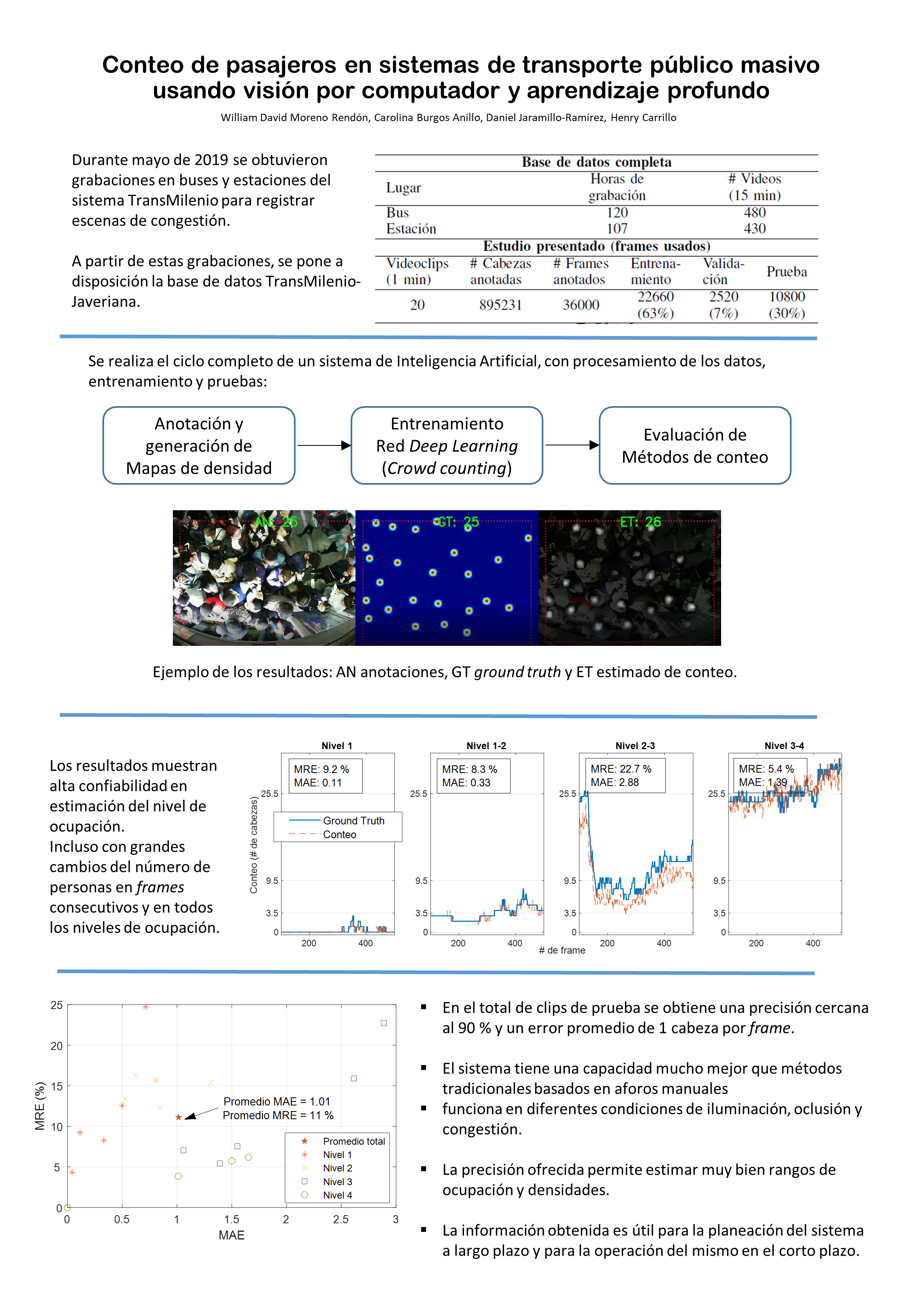Passenger Counting in Mass Public Transport Systems using Computer Vision and Deep Learning
Keywords:
Estimate counting, station door images, density maps, neural networks, computer vision.Abstract
Estimating the number of people in vehicles and stations in public transport systems is crucial to improve service quality. The TransMilenio system in Bogotá has serious drawbacks due to the lack of information in congestion situations. In this work we present a computer vision method that estimates the number of people in TransMilenio stations using deep learning techniques. We offer free use of the TransMilenio-Javeriana database with nearly 900,000 head labels on buses and stations. From these images a deep learning architecture tuned for crowd counting was trained to generate density maps around the heads in the scene. Several head count methods were evaluated on the density maps. After testing the method with 10,800 images, the results show a mean absolute error of 1 head per frame, equivalent to 11% relative error. The accuracy of this method is much better than its manual counterpart. This method is also scalable and low cost, which indicates that it has great potential to provide information for the planning and operation of public transport systems.
Downloads
References
M. Nitti, F. Pinna, L. Pintor, V. Pilloni, and B. Barabino, “Iabacus: A Wi-Fi-based automatic bus passenger counting system,” Energies, vol. 13, no. 6, 2020. 1, 2
A. Olivo, G. Maternini, and B. Barabino, “Empirical study on the accuracy and precision of automatic passenger counting in european
bus services,” The Open Transportation Journal, vol. 13, no. 1, 2019.1, 2
I. Grgurevi ́c, K. Jurˇsi ́c, and V. Rajiˇc, “Review of automatic passenger counting systems in public urban transport,” in 5th EAI Interna-
tional Conference on Management of Manufacturing Systems, pp. 1–15, Springer, 2022. 1, 2
B. F. Nielsen, L. Frølich, O. A. Nielsen, and D. Filges, “Estimating passenger numbers in trains using existing weighing capabilities,” Transport metrica A: Transport Science, vol. 10, pp. 502–517, jul 2014. 1
S. Sun, N. Akhtar, H. Song, C. Zhang, J. Li, and A. Mian, “Benchmark Data and Method for Real-Time People Counting in Cluttered Scenes Using Depth Sensors,” IEEE Transactions on Intelligent Transportation Systems, vol. 20, pp. 3599–3612, oct 2019. 2
J.-W. Perng, T.-Y. Wang, Y.-W. Hsu, and B.-F. Wu, “The design and implementation of a vision-based people counting system in buses,”
in 2016 International conference on system science and engineering (ICSSE), pp. 1–3, IEEE, 2016. 2
J. S. Lumentut, F. E. Gunawan, et al., “Evaluation of recursive background subtraction algorithms for real-time passenger counting at bus rapid transit system,” Procedia Computer Science, vol. 59, pp. 445–453, 2015. 2
T. Yahiaoui, L. Khoudour, and C. Meurie, “Real-time passenger counting in buses using dense stereovision,” Journal of Electronic Imaging, vol. 19, no. 3, p. 031202, 2010. 2
F. Li, F. Yang, H. Liang, and W. Yang, “Automatic passenger counting system for bus based on rgb-d video,” in 2nd Annual International Conference on Electronics, Electrical Engineering and Information Science, EEEIS, 2016. 2
D. P. Naranjo Valero et al., “Tiempos de ascenso y descenso de los buses de acuerdo al comportamiento de los usuarios en las estaciones tipicas de transmilenio,” 2015. 2
“ELP 170 Degree Fisheye 4K USB Webcam MJPEG 30fps 3840x2160 Mini CMOS USB Web Camera With Microphone for Desktop/Laptop PC Computer [ELP-USB4KHDR01-BL170] - $100.10 : ELP USB
Webcam.” 2
Openvinotoolkit, “Openvinotoolkit/cvat: Powerful and efficient computer vision annotation tool (cvat).” 3
D. Ttito, R. Quispe, A. R. Rivera, and H. Pedrini, “Where are the People? A Multi-Stream Convolutional Neural Network for Crowd Counting via Density Map from Complex Images,” in 2019 International Conference
on Systems, Signals and Image Processing (IWSSIP), pp. 241–246, 2019. 3
V. Sindagi, “crowdcount-mcnn.” direccion: https://github.com/svishwa/crowdcount-mcnn, 2017. 3, 4
D. Verona, “deep-crowd-counting crowdnet.” direccion: https://github.com/davideverona/deep-crowd-counting crowdnet, 2016. 3
S. Yellapragada, “Common loss functions that you should know!.” direccion: https://medium.com/ml-cheat-sheet/winning-at-loss-functions-common-loss-functions-that-you-should-know-a72c1802ecb4, 2020. 4
Y. Zhang, D. Zhou, S. Chen, S. Gao, and Y. Ma, “Single-Image Crowd Counting via Multi-Column Convolutional Neural Network,” in 2016 IEEE Conference on Computer Vision and Pattern Recognition (CVPR), pp. 589–597, IEEE, jun 2016. 4


